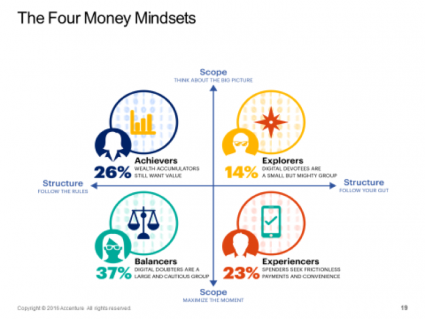
The payments industry is at a crossroads: While consumers crave the availability of digitally powered commerce, they still rely on traditional payment methods. This year’s North America Consumer Digital Payments Survey from Accenture reveals that, while digital payments have revitalized the payments space, it will still take more for digital to truly put paper and plastic payments to rest.
While digital payments are quickly transforming the way consumers pay, it’s clear that both paper and plastic payment methods are far from dead.
There’s no question that digital payments have built a strong foundation — standardized technology is optimizing transactions, tokenization is keeping data secure and consumers are more aware than ever of payments innovation.
But it’s still not enough.
The 2016 North America Consumer Digital Payments Survey from Accenture, which analyzed the responses of 4,000 North American consumers, revealed that, while digital payments bring a lot to the table, consumers are expecting more.
What’s continuing to drive consumer choice when it comes to digital payments is personalization and how value is delivered, Swee-May Ngeow, managing director at Accenture, explained.
When everything typically works the way it should — cash counts, cards swipe, chips ensure and taps pay — consumer experience becomes critical to winning consumer preference.
Accenture’s data shows that, in order for digital payments to become the go-to for consumers, providers must master value delivery.
“With all of the digital payments, the new methods of payments and the innovation that’s happening, adoption still has to overcome consumers’ habits,” Ngeow pointed out.
“Cash and plastic are still the habit and what people know, so to overcome that, providers have to offer additional value into the customer experience, both before and after the transaction itself.”
Three Key Trends Shaping the Market
The Digital Momentum
Not only are consumers more aware of digital payments, but it’s expected that they will use digital payments more as time goes on.
Transacting is already a mainstay in the daily lives of consumers; the challenge now is to make digital payments just as mainstream.
According to the Accenture survey, over half (56 percent) of consumers understand that technology is available that enables using their phone to make payments, up 4 percent from last year. The year-over-year data suggests that this upward trend will only continue.
The early adopters of payments — namely millennials and mass affluents — have become significant drivers in the consumer movement to mobile. Accenture’s data found that 35 percent of early adopters regularly use mobile phones to pay online, compared to 23 percent of average consumers.
“While millennials and the mass affluents are the first movers in the digital payments space, what was surprising from the survey is that consumers are placing a lot of trust in traditional card providers and established players, more so than what was expected in comparison to the large tech companies and the FinTechs,” Ngeow explained.
Tipping The Value Balance
Consumers have not crowned a digital payments leader, even though they trust traditional providers the most. This makes it anyone’s game to win at scale.
Consumers have set the baseline of trust — they expect their money to be secure, their personal data to be protected and the assurance that they are safeguarded against fraud. When it comes to placing trust in a mobile payments provider, consumers look to traditional card providers (73 percent), alternative payment providers (63 percent), established retail banks (62 percent) and larger tech companies (59 percent) above tech startups.
While tech companies may have been the catalyst in the digital payments revolution, Accenture’s research shows that traditional payments players are not sleeping giants but are awake and actively pursuing the digital payments opportunity.
That’s where value delivery comes in.
If digital payments players want to master the payments space, it starts with elevating their relationships with consumers and delivering value beyond the transaction.
Extending the value proposition means being ready and able to deliver on next-generation services, such as developing standards for the digital delivery of loyalty rewards and offers, as well as using application programming interfaces (APIs) to open up banking to third-party products and services.
Capitalizing On First Movers
In tracking the first-mover status of millennials in digital payments, Accenture found that this fully digital native generation has become even more interested in, and more likely to use, digital payments.
The same can be said for the mass affluents group.
Millennials and mass affluents are considered trailblazers in the digital payments landscape and share a general attitude toward new technology. According to the research, 52 percent of both groups say they are the very first or one of the first to try new technology, compared to just 39 percent of all other survey respondents.
With a strong openness to digital payments experimentation, millennials and mass affluents continue to be intrigued by the newest forms of digital payments — making them more open to the use of real-time computing devices connected to the internet to make payments, while trading personal data for perceived digital payments value. While only 21 percent of their peers are comfortable linking personal data with different ways to pay for faster authentication and one-step checkout, 26 percent of millennials and 34 percent of mass affluents are open to this process.
See Consumers For How They See Money
But in the pursuit to capture consumer mindshare in digital payments, providers can’t rely on run-of-the-mill experiences built for everyone and tailored to no one.
Traditional customer segmentation — categorizing consumers based on factors such as age, income, marital status or ZIP code — may not go far enough in delivering the customer insights providers need.
Accenture’s Money Mindsets segmentation framework provides an entirely new way for payments providers to look at customer segmentation with the hope of delivering more value in the methods of payment offered.
The Money Mindsets are based on how consumers formulate and define their approach to money and what they focus on when thinking of money.
“It’s a different way of thinking about how to design your payments products. Instead of just designing the product to fit a need, it should be about designing for mindsets and emotion,” Ngeow said. “This is a key takeaway that can help payments providers develop products and services that fit their customers.”
 Ngeow explained that Explorers (14 percent of survey respondents) are digital devotees interested in all things digital to manage their money and would be interested in cutting-edge payments options. Achievers (26 percent of respondents) are wealth accumulators who want value-added services to manage their complex financial needs and would be interested in adding personal finance advisory services to their portfolios. The next category, Experiencers (23 percent of respondents), are really just looking at the experience and how seamless and frictionless those experiences around payments can be, Ngeow added. Finally, the Balancers (the largest group at 37 percent) are digital doubters who are very cautious when it comes to payments and need to be educated to build their comfort and confidence in digital payments and services, such as bill payments and advisory services to avoid overdrafts.
Ngeow explained that Explorers (14 percent of survey respondents) are digital devotees interested in all things digital to manage their money and would be interested in cutting-edge payments options. Achievers (26 percent of respondents) are wealth accumulators who want value-added services to manage their complex financial needs and would be interested in adding personal finance advisory services to their portfolios. The next category, Experiencers (23 percent of respondents), are really just looking at the experience and how seamless and frictionless those experiences around payments can be, Ngeow added. Finally, the Balancers (the largest group at 37 percent) are digital doubters who are very cautious when it comes to payments and need to be educated to build their comfort and confidence in digital payments and services, such as bill payments and advisory services to avoid overdrafts.
This analysis provides a new understanding of who today’s digital payments customers are and an opportunity for payments providers to target products and services — and customer value — based on behavior and emotion.
Customers require different and distinct payment services and experiences based on their unique Money Mindset. This is why personalization is so important for success in the digital payments world. Serving customers is about knowing who they are, not just how they pay.
To learn more about the key findings from Accenture’s 2016 North America Consumer Digital Payments Survey, click here.